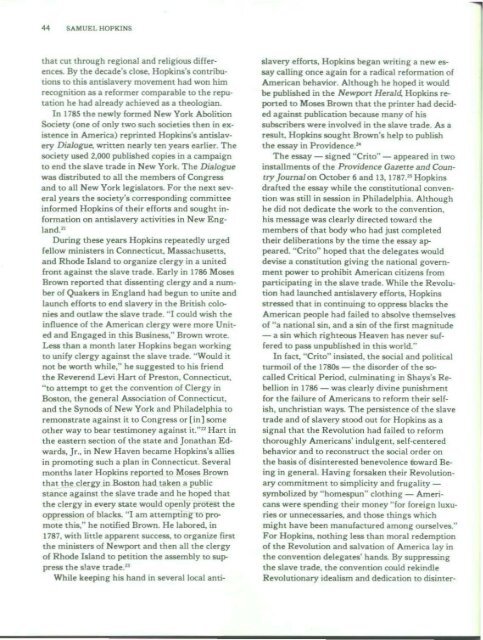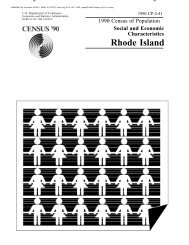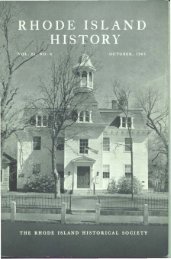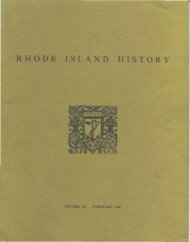RHODE ISLAND HISTORY - Rhode Island Historical Society
RHODE ISLAND HISTORY - Rhode Island Historical Society
RHODE ISLAND HISTORY - Rhode Island Historical Society
- No tags were found...
You also want an ePaper? Increase the reach of your titles
YUMPU automatically turns print PDFs into web optimized ePapers that Google loves.
44 SAMUEL HOPKINSthat cut through regional and religious differences.By the decade's close, Hopkins's contributionsto this antislavery movement had won himrecognition as a reformer compa rable to the reputationhe had already achieved as a theologian.In 1785 the newly formed New York Abolition<strong>Society</strong> (one of only two such societies then in existencein Am erica) reprinted Hopkins's antislaveryDialogue, written nearly ten years earlier. T h esociety UK'd 2,000 published copies in a campaignto end the slave trade in New Yor k. The Dialoguewas distributed to all the members of Congressand to all New York legislators. For the ne xt severalyears the society's corresponding com mitteeinformed Hopkins of thei r efforts and sought informationon antis lavery activities in New England."During these years Hopkins repeatedly ur gedfellow ministe rs in Connec ticut, Massa chusetts,and <strong>Rhode</strong> <strong>Island</strong> to organize clergy in a unitedfront against the slave trade. Early in 1786 MosesBrown reported that dissenting clergy and a numberof Quakers in England had begun to unite andlaunch efforts to end slavery in the British coloniesand outlaw the slave trade. "I could wish theinfluence of the American clergy were more Unitedand Engaged in this Business," Brown wrote.Less than a month later Hopkins began workingto unify cle rgy against the slave trade. "Would itnot be worth while ," he suggested to his friendthe Rever end Levi Han of Preston, Connecticut,"to attempt to get the convention of Clergy inBoston, the general Association of Connecticut,and the Synods of New York and Philadelphia torem onst rate against it to Congress or (in] someothe r way to bear test imo ney against it.":Z Hart inth e eastern section of the state and Jonathan Edwards,j r., in New H aven became Hopkins's alli esin promotin g such a plan in Connecticut. Severalmonths later Hop kins reponed to Moses Brownthat the clergy in Boston had taken a publicstance against the slave trade and he hoped thatthe clergy in every state would ope nly pro test theoppression of blacks. "I am attempting to pr0mote this," he notified Brown. He labored, in1787, with little apparent success, to organize firstthe ministers of Newport and then all the clergyof <strong>Rhode</strong> <strong>Island</strong> to petition the assembly to suppressthe slave trade."Wh ile keepin g his hand in several local antislaveryefforts, Hopkins began writing a ne w essaycalling once again for a radical reformation ofAmerican behavior. Although he hoped it wouldbe published in the N ewport Herald, Hopkins reponed.to Moses Brown that the printer had decid ed against publication because many of hissubscribers were involved in the slave trade. As aresult, Hopkins sought Brown's help to publishthe essay in Providence."The essay - sig ned "Crito" - appeared in twoinstallments of the P ro vidence Gazette and CountryJoumal on October 6 an d 13, 1787.n Hopk insdrafted. the essay wh ile the constitutional conventionwas still in session in Philadelphia. Althoughhe did not dedicate th e work to the convention,his m essage was clearly dir ect ed toward themembers of that body wh o ha d just completedthe ir de libera tions by the ti me the essay appeared."Crito" hoped that the delegates woulddevise a constitution giving the national governmentpower to prohibit Am erican citizens fromparticipating in the slave trade. While the Revolutionhad launched antislavery efforts, Hopkinsstressed that in continuing to oppress blacks theAmerican people had failed to absolve themselvesof "a national sin, and a sin of the first magnitude- a sin which righteous Heaven has never sufferedto pass unpublished in this world."In Iact, "Crieo" insis ted, the social and politicalturmoil o f the 1780s - the disorder of the socalledCritical Period, culminating in Shays's Rebellionin 1786 - was clearly divine punishmentfor the failu re of Americans to reform their selfish,unc hristian ways. The persistence of the slavetrade and of slavery stood ou t for Hopk ins as asigna l that the Revolution had failed to refor mthorou ghly American s' indu lgent, self-cent eredbeh avior and to reconstruct the social order onthe basis of disinterested benevolence toward Beingin ge ne ral. Havin g forsaken their Revolutionarycommit m ent to simplicity and frugality symbolized by "homespun" clothing - Americanswere spen ding their money "for foreign luxu ries or unnecesseries, and those things whichmight have been manufactured among ourselves."For Hop kins. nothing less than moral redemptionof the Revolution and salvation of America lay inthe convention delegates' hands. By suppressingthe sla ve trade, the convention could rekindleRevolutionary idealism and ded ication to disinter-











